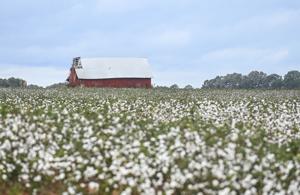UPDATE: As cotton harvesting kicks off in Alabama, local farmers are sounding alarms over devastating tariffs impacting their livelihoods. Greyson Lauderdale, a cotton farmer from Elkmont, revealed that prices have plummeted to around 68 cents per pound, significantly below production costs. “We’re struggling to stay afloat,” Lauderdale emphasized, highlighting the severe consequences of the ongoing trade war with China.
With exports historically accounting for approximately 85% of the U.S. cotton market, the lack of a trade deal is creating a ripple effect felt by farmers nationwide. “Most of our cotton is ginned here, then shipped overseas to be spun and sent back,” Lauderdale explained, illustrating the detrimental impact of tariffs on their business.
According to Josh Lee, a cotton agronomist with the Auburn University Cooperative Extension Service, the current price of cotton remains alarmingly low. “The demand for cotton is lower at this moment, and prices fluctuate daily. We need to see it closer to $1 per pound to ensure profitability,” Lee stated.
In a glimmer of hope, recent legislation known as the One Big, Beautiful Bill (OBBB Act) aims to bolster support for cotton farmers. This legislation adds $65.5 billion to agricultural programs, enhancing safety nets for growers. Under the new law, the Price Loss Coverage reference price for cotton is set to rise from about $41 per acre to approximately $127 per acre.
“This should give cotton growers better security and stability,” Lee noted. “It’s designed to keep cotton production domestic, which is crucial for our farmers.” With these changes, farmers can receive payments when prices fall below certain thresholds, cushioning the blow of fluctuating market conditions.
Harvesting is already underway, with Lee estimating that about 30% of Alabama’s cotton has been collected. “The yield this year seems comparable to last year, with good quality on the bottom due to reduced bole rot, thanks to the dry weather,” he reported.
However, the impact of delayed planting—caused by excessive rainfall—could mean mixed results for some farmers. Lauderdale, who planted 850 acres of cotton, anticipates varied quality in his harvest. “We might end up with both great cotton and some that falls short,” he warned.
Billy Stickler, general manager of the Associated Grower’s Co-Op in Limestone County, confirmed that as of last Friday, they had ginned 1,900 bales of cotton, but he noted that yields are expected to drop this year. “Wet weather has delayed planting and reduced acreage by about 30% in several counties,” Stickler shared.
The quality of this year’s crop remains uncertain, as Stickler has yet to receive many grades back. “It’s too early to tell, but the quality could be spotty,” he cautioned.
As farmers face these immediate challenges, the agricultural community is watching closely for any developments regarding trade negotiations and market demand. The urgency of the situation is palpable, and farmers are hoping for a turnaround as they navigate this tumultuous season.







































































